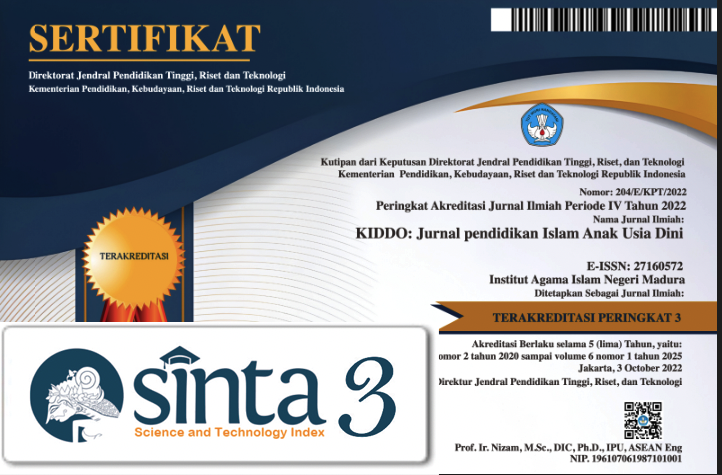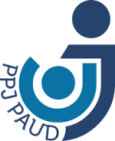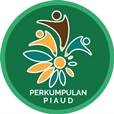Yoga Asana For Early Children's Physical Motoric Development
 Abstract views: 293
,
Abstract views: 293
,
 PDF downloads: 294
PDF downloads: 294
Abstract
Physical and motor skills can affect the way people view themselves and their environment. Physical and motor development in early childhood is very influential in shaping the child's personality and development thoroughly. This research aims to describe asana yoga for the physical development of early childhood motor, using qualitative research case study of research site in PAUD Bali Public School Denpasar. The main data source consists of teachers, students and five-and six-year-old schoolgirls and a yoga instructor. Data collection procedures using observation techniques, interviews and documentation studies. While the data analysis is done during the ongoing research (on going proccess) with the stages of data reduction, data presentation and data verification as well as data validationin the form of data triangulation and member check. The results of the research was obtained by the data that the yoga asana for early childhood in PAUD Bali Public School Denpasar is a routine event Monday through Friday. Asana Yoga is performed for five to ten minutes with various types of poses including cobra pose, tree pose, lion pose, lotus pose. Asana Yoga is presented in the form of story telling and games adapted to the theme of the PAUD Daily Learning Implementation Plan (RPPH) such as animal themes, plants or environmental themes. The results of research in the field obtained data that, after the child performs regular yoga for three to six months with the correct movements, a significant increase in physical development as well motor and crude. Motor physical development in early childhood affects the development of the child in the future, to achieve optimal motor physical development should be given stimulation or stimulus in a variety of fun ways and in accordance with the growth stage of early childhood children
Downloads
References
Aghnaita. (2017). Perkembangan Fisik-Motorik Anak 4-5 Tahun Pada Permendikbud no . 137 Tahun 2014 ( kajian konsep perkembangan anak ). Ejournal.Uin-Suka.Ac.Id/Tarbiyah/Alath, 3(137).
Dayuh, I. N. (2016). Pengetahuan Spiritual Yoga. Jurnal Penjaminan Mutu, 1(2), 79. https://doi.org/10.25078/jpm.v1i2.53
Farahani, P. V, & Khonsari, A. H. (2018). Effectiveness of super brain yoga for children with hyperactivity disorder. Wiley Journal, December 2017, 1–7. https://doi.org/10.1111/ppc.12266
Kaplan, L. J. (2013). The Experience of Yoga on Children with Anxiety. Master of Social Work Clinical Research Papers. St Catherine University, 1–55.
Kemendikbud. (2017). Modul pelatihan pendidikan karakter bagi guru. 50.
Kinasih, A. S. (2010). PENGARUH LATIHAN YOGA TERHADAP. 18(1), 1–12.
Miles, M., & Huberman, M. (1992). Qualitative Data Analysis (Diterjemahkan oleh Rohidi (ed.); Cetakan pe). Universitas Indonesia (UI-Press).
Rahman, T., & Fuadatun, F. (2017). Peningkatan Kemampuan Anak Usia Dini Mengenal Konsep Bilangan melalui Media Flashcard. Jurnal Paud Agapedia, 1(1), 118–128.
Russo, H. L. (2013). Play and Creativity at the center of Curriculum and Assessment: A New York City School’s Journey to Re-Think Curricular Pedagogy. Bordón. Journal of Education, 65(1), 131–146. https://doi.org/10.13042/brp.2013.65109
Siti Maulani, Fanny Rizkiyani, & Sari, D. Y. (2021). Pemahaman Orang Tua Mengenai Gizi Seimbang pada Anak Usia 4-5 Tahun. Kiddo: Jurnal Pendidikan Islam Anak Usia Dini, 2(2), 154–168. https://doi.org/10.19105/kiddo.v2i2.4186
Stapp, A., & K Wolff. (2019). Investigating Early Childhood Teachers ’ Perceptions of a Preschool Yoga Program. SAGE JOURNAL, jANUARY-m, SAGE Open January-March 2019: 1 –9 © The Author(s). https://doi.org/10.1177/2158244018821758
Suyadi, Wina Calista, D. P. (2018). Perkembangan Fisik-Motorik Siswa Usia Dasar: Masalah dan Perkembangannya. JIP :Jurnal Ilmiah PGMI, 4(2), 170–182.
Timmons, B. W., Leblanc, A. G., Carson, V., Gorber, S. C., Dillman, C., Janssen, I., Kho, M. E., Spence, J. C., Stearns, J. A., & Tremblay, M. S. (2012). Systematic review of physical activity and health in the early years ( aged 0 – 4 years ). 792, 773–792. https://doi.org/10.1139/H2012-070
Wahyuni, S., & Usman, J. (2020). Penerapan Permainan Maze dalam Pembelajaran untuk Pengembangan Kognitif Anak di TK PKK Jalmak Desa Jalmak Kecamatan Pamekasan Kabupaten Pamekasan Jawa Timur. Kiddo: Jurnal Pendidikan Islam Anak Usia Dini, 1(2), 160–173. https://doi.org/10.19105/kiddo.v1i2.3687
White, L. S. (2009). Yoga for Children. Pediatric Nursing Education Series, 35(5), 296–297.
Widya Sena, I. G. M. (2018). Kinesiologi Yoga Asanas (Kunci Kebahagiaan Tubuh, Pikiran Dan Jiwa). Jurnal Yoga Dan Kesehatan, 1(Kinesiologi yoga), 15–21. https://ejournal.ihdn.ac.id/index.php/jyk/article/view/554
Young, A. J., & Silliman-french, L. (2017). YOGA FOR YOUNG CHILDREN WITH DOWN SYNDROME. 31(3), 18–25.
Zeng, N., Ayyub, M., Sun, H., Wen, X., Xiang, P., & Gao, Z. (2017). Effects of Physical Activity on Motor Skills and Cognitive Development in Early Childhood : A Systematic Review. Hindawi BioMed Research International Volume 2017, Article ID 2760716, 13 Pages, 2017, 13.
-
The journal operates an Open Access policy under a Creative Commons 4.0 International license. The terms of the license are:
Share— copy and redistribute the material in any medium or format
Adapt— remix, transform, and build upon the material for any purpose, even commercially.
1. Authors retain copyright and grant the journal right of first publication with the work simultaneously licensed under a Creative Commons License.that allows others to share the work with an acknowledgement of the work’s authorship and initial publication in this journal
2. Authors are permitted and encouraged to post their work online (e.g., in institutional repositories or on their website) prior to and during the submission process, as it can lead to productive exchanges, as well as earlier and greater citation of published work (See The Effect of Open Access).
Jurnal Kiddo is licensed under a Creative Commons
n Access).














